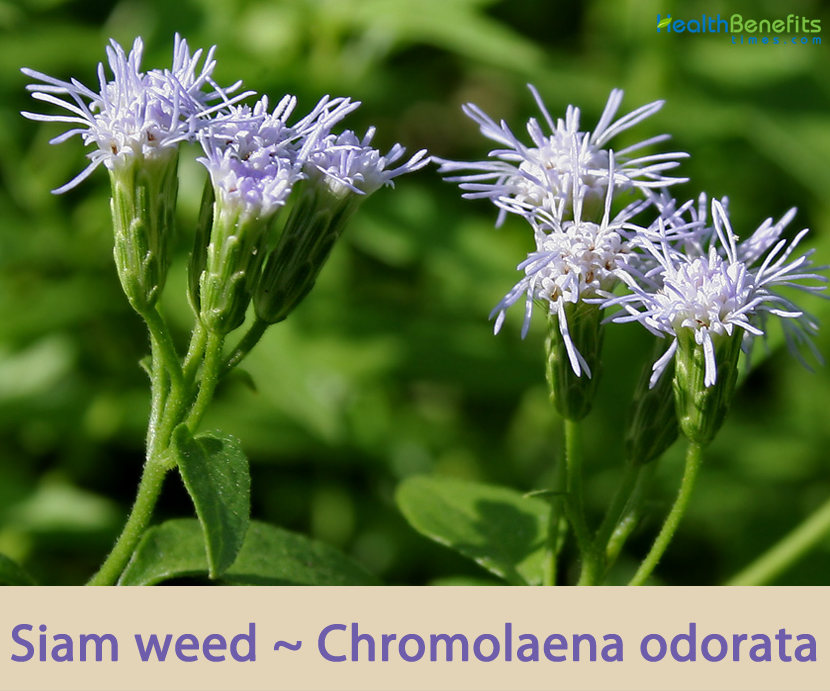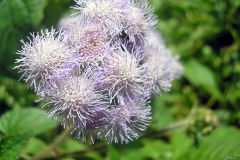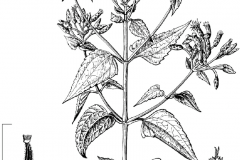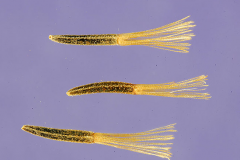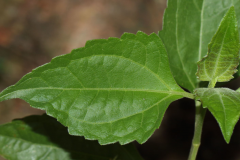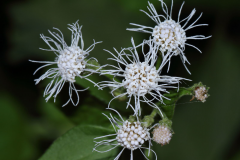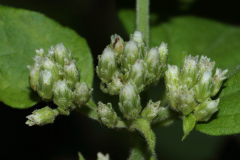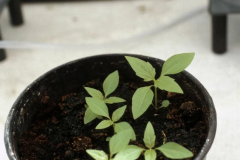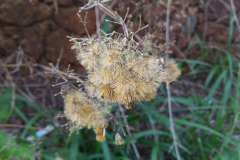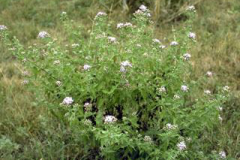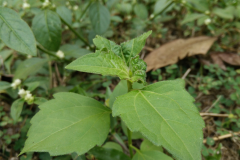| Siam weed Quick Facts | |
|---|---|
| Name: | Siam weed |
| Scientific Name: | Chromolaena odorata |
| Origin | Warmer parts of south-eastern USA (i.e. southern Florida and Texas), Mexico, the Caribbean and tropical South America |
| Colors | Brown or black |
| Shapes | Narrow and elongated, black or dark brown seeds (achenes) that are 4-5 mm long and topped with a ring (pappus) of white to brownish coloured hairs (5-6 mm long). |
| Health benefits | Serves as Vertigo Medicine, Maintains or protects the, Reproduction Organ, Cure Foot Rot, Reduces Blood Pressure, Good for Stomach’s Health, Helps with Clotting, Prevents Cervical Cancer, Helps with Ulcer, Decreases Cholesterol Levels, Used For Diabetes, Maintains Heart Health, Relieves Pain |
| Name | Siam weed |
|---|---|
| Scientific Name | Chromolaena odorata |
| Native | Warmer parts of south-eastern USA (i.e. southern Florida and Texas), Mexico, the Caribbean and tropical South America (i.e. French Guiana, Guyana, Surinam, Venezuela, Bolivia, Colombia, Ecuador, Peru, Paraguay, Brazil and northern Argentina). It has been introduced to tropical Asia, West Africa, and parts of Australia |
| Common Names | Armstrong’s weed, baby tea, bitter bush, butterfly weed, Christmas bush, chromolaena, devil weed, eupatorium, Jack in the bush, Jack-in-the-bush, kingweed, paraffinbush, paraffinweed, Siam weed, turpentine weed, triffid weed, hagonoy, archangel, devil weed |
| Name in Other Languages | Afrikaans: Sekou toure, Acheampong, Jabinde, Matapa, Mighbe, Paraffienbos Assamese: Bagh dhaka bon, Jarmani bon, Jarmoni-bon, Koli bon, Nogor bera Australia: Butterfly-weed, devilweed, hagonoy, jack-in-the-bush Belize: Yaxhatz Bengali: Assam lata, Bana maṭamaṭiẏā (বন মটমটিয়া) Bodo: Bangri lewa Bolivia: Sisi cayaya Burmese: Pi hcaut (ပိစပ်) Cambodian: Kantreang’khaet, Tonoor Caribbean: Bushy thoroughwort, Christmas rose, guérit-tout, guérit-trop-vite, hemp agrimony, jack-in-the-bush, tonka bean Central African Republic: Apollo, bokassa, jabiinde Central Khmer: Tontrean khe t (ទន្ទ្រានខេត) Chamorro: Masigsig Chinese: Fei ji cao (飞机草), Xiāngzé lán (香澤蘭) Chuukese: Otuot Colombia: Varejón de caballo Congo: Comilog, Diabantou, Kalamana, Kalamilebe, Matapa mbala, Rwandais, Yhombi, lantana of Ngouabi Cote d’Ivoire: Sekou toure, indépendance Cuban: Rompezaraguey Dominican Republic: Niquibey, rompesaraguey El Salvador: Chimuyo English: Christmasbush, Jack in the bush, Siamweed, Bitter bush, Butterfly-weed, Devil weed, Hagonoy, Jack-in-the-bush, Paraffin-weed, Triffid weed, archangel, awolowo weed, paraffin bush, sam-solokh, White snake root, Common Floss Flower Filipino: Agonoi, huluhagonoi French: Herbe du Laos, Eupatoire odorante, Fleurit-Noël, languè a chat German: Siam kraut Guam: Kesengesil, Masigsig Haitian: Lang-chat Hindi: Bagh dhoka, Tivra gandha (तीव्र गंधा), ashoke lata, Eupatorium, Sam-solokh Honduras: Crucito, rey del todo Indonesian: Rumput putih, Rumput golkar, Kirinyuh, Kopasanda, fausse ramie, Siamweed Irula: Madras poo, Naadukadi chedi Japanese: Himawarihiyodori (ヒマワリヒヨドリ) Kapampangan: Malapasi Karbi: Kal bun Kosraean: Mahsrihsrihk Laos: Nha flang, nroj pawm thsis Malay: Herba, Kapal terbang, Pokok Kapal Terbang Malayalam: Communist pacha, kam’myuṇisṟṟ pacca (കമ്മ്യുണിസ്റ്റ് പച്ച), Venappacha, Assam pacha, kamyūṇisṟṟ pacca (കമ്യൂണിസ്റ്റ് പച്ച) Malaysian: Fausse ramie, Maeanum, Pokok german Mexico: Chiguapatzle, cihuapatli, crucito, xtokabal Micronesia, Federated states of: Floss flower, mahsruhsrihk, otuot, wisolmat en rehwei (Pohnpei) Mizo: Tlangsam Myanmar: Bizat, taw-bizat Nepali: Barnmara, Aule Banamaaraa (औले वनमारा), Banamaasuwaa (बनमासुवा) Nicaraguan: Crucito olorosa, Garrapata Nigerian: Bienqua Palauan: Kesengesil, ngesngesil Panama: Hierba de Chiva, Paleca Peru: Chisca Philippines: Agonoi, daladay, devil weed, gonoi, hulohagonoy, huluhagonoi, lahuneri, malasili, talpuspalad Pohnpeian: Masigsig, masikisik, wisolmat, wisolmat en rehnwel Portuguese: Picão Puerto Rico: Cariaquillo Santa Maria, Santa Maria Russian: Khromolena dushistaya (Хромолена душистая) Saint Lucia: Jack in the bush Sanskrit: Ropani, Seekhrasarpi South Africa: Amstrong’s weed, Armstrong weed, eupatorium, isandanezwa, kingsweed, paraffienbos, paraffin weed, parrafinbush, triffid weed, turpentine weed Spanish: Cariaquillo Santa Maria, Chiimuyo, Crucito, Eupatorio oloroso, Hierba de chiva, Rey del todo, paleca, cuarina de monte, niquibey, chismuyo, paleca, langa chata, Santa María, alfombrilla de altura, bejuco lila, candelilla, Canutillo, crucetilla, crucita olorosa, cruz de campo, cruz-quen, cruz-quen, curarina, curarina de monte, garrapata, lila, mejorana, suplicio, tocabal, tocaban, tres putas, vara negra, xtokabal Sri Lanka: Mile-a-minute Tangkhul: Sheleirung Thai: Sab suea (สาบเสือ) United States Virgin Islands: Geritoo Vietnamese: Co hoi, Yen-bach, Bớp bớp |
| Plant Growth Habit | Upright or sprawling, rapidly growing, herbaceous semi-woody to woody perennial shrub |
| Growing Climates | Croplands, neglected pastures, forest margins, disturbed rainforests, cultivated lands, forest clearings, wastelands, along forest trails, fence rows, roadsides, waterways, bush land, riparian zones, disturbed sites, agricultural areas, natural forests, planted forests and grasslands |
| Soil | Grows in many soil types but prefers well-drained soils. It does not tolerate shade and thrives well in open areas |
| Plant Size | Usually growing 1.5 to 3 m tall in the open, however it may reach greater heights (6-20 m) when climbing over trees and other taller vegetation |
| Root | Shallow, fibrous abundantly branched root that does not penetrate beyond 20-30cm in most soils |
| Stem | Stems are smooth, round, fairly brittle, base becomes woody when old. |
| Twigs | Twigs are slightly striolate longitudinally, pubescent, opposite-decussate |
| Leaf | Leaves are simple, oppositely arranged leaves are 5-12 cm long and 3-7 cm wide and are triangular or egg-shaped in outline (i.e. ovate) and have a pointed tip (i.e. acute apex). They are hairy (i.e. pubescent) on both surfaces and have coarsely toothed (i.e. serrated) margins |
| Flowering season | December-March |
| Flower | Small flower-heads (capitula) do not have any petals (ray florets) and are borne in dense clusters at the ends of the branches (in terminal panicles). These flower-heads are about 10 mm long and 3 mm wide and are pale pink or pale mauve in color (sometimes appearing whitish when older) and consist of numerous (15-30) tiny flowers (tubular florets). |
| Fruit Shape & Size | Narrow and elongated, black or dark brown seeds (achenes) that are 4-5 mm long and topped with a ring (pappus) of white to brownish coloured hairs (5-6 mm long) |
| Fruit Color | Brown or black |
| Seed | Seeds are dark, 4 to 5 millimeters, narrow and oblong, with a parachute of white hairs which turn brown as the seeds dry |
| Propagation | By seeds and vegetatively from cut basal shoots |
| Flavor/Aroma | Pungent, aromatic odor |
| Plant Parts Used | Leaves, flower |
| Lifespan | 10-year life span |
| Season | Throughout the year |
| Health Benefits |
|
Plant Description
Siam weed is an upright or sprawling, rapidly growing, herbaceous semi-woody to woody perennial shrub that normally grows about 1.5 to 3 m tall in the open, however it may reach greater heights about 6-20 m when climbing over trees and other taller vegetation. The plant is found growing in croplands, neglected pastures, forest margins, disturbed rainforests, cultivated lands, forest clearings, wastelands, along forest trails, fence rows, roadsides, waterways, bush land, riparian zones, disturbed sites, agricultural areas, natural forests, planted forests and grasslands. The plant grows in many soil types but prefers well-drained soils. It does not tolerate shade and thrives well in open areas. The plant has shallow, fibrous abundantly branched root that does not penetrate beyond 20-30 cm in most soils. Many paired branches grow off the main stem. The base of the plant becomes hard and woody while the branch tips are soft and green. It has soft stems but the base of the shrub is woody. In shady areas it becomes etiolated and behaves as a creeper, growing on other vegetation.
Stems
The slender stems are generally yellowish-green and somewhat hairy (i.e. pubescent), but become woody towards the base of the plant. These stems grow up to 7 m or more in length and several are usually produced from the plants long-lived root-stock (i.e. crown). They are much-branched, with the side (i.e. lateral) branches usually being produced in pairs in the leaf forks (i.e. axils).
Leaves
The oppositely arranged leaves are 5-12 cm long and 3-7 cm wide and are triangular or egg-shaped in outline (i.e. ovate) and have a pointed tip (i.e. acute apex). They are hairy (i.e. pubescent) on both surfaces and have coarsely toothed (i.e. serrated) margins. These leaves are borne on stalks (i.e. petioles) up to 6 cm long (usually 10-15 mm), and give off a strong pungent, aromatic odor when crushed.
Flowers
The small flower-heads (capitula) do not have any petals (ray florets) and are borne in dense clusters at the ends of the branches (in terminal panicles). These flower-heads are about 10 mm long and 3 mm wide and are pale pink or pale mauve in color (sometimes appearing whitish when older) and consist of numerous (15-30) tiny flowers (tubular florets). These tiny flowers are 10-12 mm long and are surrounded by several layers of overlapping slender bracts (an involucre) 8-9 mm long. Each flower-head (capitulum) is borne on a stalk (peduncle) 10-30 mm long. Flowering normally takes place in between December and March.
Fruit
Fertile flowers are followed by narrow and elongated, black or dark brown seeds (achenes) that are 4-5 mm long and topped with a ring (pappus) of white to brownish coloured hairs (5-6 mm long).They are mostly spread by the wind, but can also cling to fur, clothes and machinery, enabling long distance dispersal. Seed production is about 80000 to 90000 per plant. Seeds need light to germinate. The plant can regenerate from the roots. In favorable conditions the plant can grow more than 3 cm per day.
Health benefits of Siam Weed
Siam weed consists of carbohydrate, protein, lipid, fiber, calcium, magnesium, iron, as well as flavonoids, alkaloids, tannins, saponins, and more. Today, we are trying to understand more about the plant by looking at some of its health benefits. Listed below are some of the well-known health benefits of Siam weed
1. Relieves Pain
Siam weed can be used to relieve body pain. You have the option of drinking its juice to find relief from internal body pain, such as back pain. You can also use it as an analgesic for joint pain by crushing the leaves and rubbing them on the affected area.
2. Maintains Heart Health
Siam weed also help to maintain your heart health by preventing several heart diseases. Including Siam weed to your diet can help to protect your heart and keep it healthy.
3. Used For Diabetes
Siam weed can be quite beneficial for those with diabetes as it helps to reduce blood sugar levels, allowing them to cope with their condition better. It can also be taken by those looking for a way to prevent diabetes. One study on streptozotocin-induced diabetic rats suggested that extract of Siam weed can help in reducing glucose, HOMA, lipid profiles. As well as significantly improving glucose and insulin tolerance, glycogen content, glucose uptake by skeletal muscle, serum insulin and HDL-c levels.
4. Decreases Cholesterol Levels
High cholesterol levels in the body are very bad and can lead to heart problems. Boiling Siam weed in water and drinking it is a sure and effective way to reduce your cholesterol levels. Research on rats suggested the anti-cholesterolemic effect of aqueous extract of the leaves of Siam weed. Research concluded that Siam weed may be beneficial in lowering cholesterol and prevent cardiovascular complications.
5. Helps with Ulcer
Siam weed can help in dealing with ulcer effectively, as it helps kill Helicobacter Pylori, which is a bacterium that causes ulcer. It also helps to prevent the possibility of a relapse.
6. Prevents Cervical Cancer
Cervical cancer is one of the diseases that are quite dangerous for women. The use of Siam weed is very effective in the fight against cervical cancer due to its anticancer effect or property.
7. Helps with Clotting
Siam weed is considered as one of the powerful clotting agent and can help to stop bleeding in very little time. Due to this reason it is often used as a form of local first aid. Just rubbing the leaves on fresh injuries and wounds would help to stop the bleeding and would also sterilize the wound. Many medical researchers have confirmed the wound healing abilities of Siam weed.
8. Good for Stomach’s Health
The nutrition contents in Siam weed leaves are very good for those of you who suffer from stomach-related diseases or nuisances.
9. Reduces Blood Pressure
Siam weed helps to reduce blood pressure and helps to maintain a healthy balance. This makes it very beneficial to those who are hypertensive.
10. Cure Foot Rot
Siam weed helps to cure foot rot speedily. Squeeze it in your palm and apply it on the affected area. You will see results in 3 days.
11. Maintains or protects the Reproduction Organ
The health of reproduction organs is one of the very important things that need to be aware of especially the women. The chemical and the nutritional effects loaded in Siam weed helps to maintain the reproductive organ. One can consume the Siam weed brewed water to get these results.
12. Serves as Vertigo Medicine
Siam weed is loaded with super chemical and nutritional effects and for that matter the regular consumption of its makes it very reliable for fighting vertigo diseases. You can cure the disease by drinking the Siam weed brewed water.
Traditional uses and benefits of Siam Weed
- In Malaysia, where Siam weed is an invasive exotic, plant parts are used by traditional practitioners for treatment of burns, wound healing, skin infections, post-natal wounds, and as an anti-malarial.
- Several medical studies have confirmed that leaf extracts have certain anti-microbial, anti-inflammatory and wound-healing effects, and are recognized as a potential source of human medicines.
- Crushed leaves are used for kulebra, boils and tumorous inflammatory conditions in Philippines.
- Concoction of juices of leaves and fruits of hagonoy, kalamansi, dilaw, dahon ng sili, mixed with lime and honey are used for skin diseases and boils.
- It is used to stop bleeding and wound healing in several tropical countries.
- Young leaves are used to treat wounds in Indonesia.
- Aqueous extract of leaves used for the treatment of soft tissue wounds, burn wounds, and skin infections in Vietnam.
- Juices extracted from pounded leaves, mixed with honey, castor oil, and olive oil, used for colds and flu in Antilles.
- Tea of leaves used for bles.
- It is used for wound healing and as anthelmintic in Nigeria.
- It is also used for treatment of piles.
- Tender leaves are highly medicinal in intermittent fever and dysentery; also use externally in swellings, cuts and wounds.
- Sap from the crushed leaves applied on cut wounds for quick healing.
- Leave aqueous extract have been used for the treatment of soft-tissue burns or skin infections.
- Siam weed extract accelerates hemostasis and wound healing.
- In Ghana and Benin, the infusion from fresh leaves is used to treat malaria and internal hemorrhage.
- In Thailand, the leaves are used to cataplasm to stem external hemorrhage.
- In Thailand, Siam weed is traditionally used to stop bleeding in Thailand.
- Plant has many ethno-pharmacological uses, including treatment of malaria, wounds, diarrhea, skin infection, toothache, dysentery, stomach ache, sore throat, convulsions, piles, coughs and colds.
- In traditional medicine, a decoction of the leaf is used as a cough remedy and as an ingredient with lemon grass and guava leaves for the treatment of malaria.
Other Facts
- In favorable conditions the plant can grow more than 3 cm per day.
- It is a major weed in disturbed areas and coconut plantations in Sri Lanka.
- It is used extensively to improved soil fertility in Nigeria.
- Each plant can produce 800,000 seeds each year, which are readily wind dispersed.
- The leaves are used to preserve dead bodies traditionally.
- Consumption of the liquid is good for the treatment of bilharzia.
Precautions
- It is generally regarded as poisonous to animals and thus not recommended as a livestock feed.
- It may cause allergic reactions.
- This species may cause skin complaints and asthma in allergy-prone people.
Control Methods
Physical
Manual slashing, use of bush-cutter or tractor-drawn implements are commonly used methods of control. Slashing causes rapid regeneration unless followed by other methods to suppress this weed for an extended period. Manual weeding is labor intensive. Use of tractor drawn equipment is limited to areas that are accessible.
Chemical
Chemical control using herbicides applied at the seedling stage or on early regrowth has given encouraging results. Triclopyr has proven to be the most effective. However, problems in herbicide use include (a) the high cost of the chemicals and their application, (b) ecological concerns and, (c) non-compatibility in many cropping and other environmental situations.
Biological
Four insects have been released for biological control, the weevil Apion brunneonigrum, the fly Melanagromyza eupatoriella and two moths, Mescinia parvula and Pareuchaetes pseudoinsulata. Of these, only the last has become established, fairly readily in Sri Lanka, Guam and other Micronesian islands, but with some difficulty in India and Sabah (Malaysia) and it has since spread unaided to the Philippines and Brunei. It failed to become established in Thailand, Ghana, Nigeria and South Africa. It has produced spectacular defoliation and death of many plants in Guam and striking but sporadic defoliation in Sri Lanka. In India, populations have built up but damage has seldom been great. Where established, it is heavily attacked by a range of predators and these are believed to have prevented successful establishment in several countries.
References:
https://www.itis.gov/servlet/SingleRpt/SingleRpt?search_topic=TSN&search_value=37034#null
http://www.hear.org/pier/species/chromolaena_odorata.htm
https://www.cabi.org/isc/datasheet/23248
https://gd.eppo.int/taxon/EUPOD
https://en.wikipedia.org/wiki/Chromolaena_odorata
https://powo.science.kew.org/taxon/57443-2
http://www.theplantlist.org/tpl/record/gcc-24352
https://keyserver.lucidcentral.org/weeds/data/media/Html/chromolaena_odorata.htm
http://www.stuartxchange.com/Hagonoy.html
https://weeds.brisbane.qld.gov.au/weeds/siam-weed
https://indiabiodiversity.org/species/show/32547
http://www.flowersofindia.net/catalog/slides/Siam%20Weed.html
https://plants.usda.gov/home/plantProfile?symbol=CHOD


